A dream come true, or Radio 86RK - 25 years later
Back in 1986, I had a dream. Rather, the DREAM is to build your own micro-computer "Radio-86RK", the circuit of which was published in the journal "Radio" (and which has already been mentioned on Habré, for example, here - habrahabr.ru/post/172405 ).
Prior to that, I already figured out a bit with microprocessor technology a series of publications several years earlier in the same Radio about the construction of the Micro Micro 80 microcomputer. Unfortunately, the Micro 80 circuitry was extremely complex (more than 200 microcircuits), so it was almost impossible for me to repeat it, both because of the complexity of the construction and the inability to get the details.
So for the time being, I could only write programs on machine codes in a notebook in a box and dream of a magician in a helicopter of any color that would suddenly give me this very Micro 80.
The situation has changed to some extent after the publication of articles on Radio 86RK. 86РК was much simpler - it contained "only" 29 chips. Only if before that I clearly understood that there was no chance at all, then it seems like the opportunity to get my own micro-computers theoretically appeared, but practically the question with details was almost unresolved anyway.
Let me explain a little - at that time everything was in short supply, and radio components were no exception to this rule. Not only that, many parts, in principle, did not go on retail. Nevertheless, it was possible to get everything. In large cities there were places (often near shops like "Young Technician", etc.), where it was worth standing for a minute or two with an absent look, as "comrades" who were spinning nearby came up to you and casually asked - "Is something necessary? ". Naturally, such activity was completely illegal, and was regularly suppressed by the relevant law enforcement bodies. As in any criminal business, there was always a danger that you would be deliberately “thrown”, “divorced” or even “framed”. Accordingly, to me, as a resident of a small village, this option was of little use - and it was logistically extremely difficult, and it was just scary.
Therefore, my mood only got spoiled - it’s better to clearly know that this is impossible, than to constantly suffer, wondering if it is possible to dodge somehow and find the necessary components. A couple of years passed in such torment, I went to study at a university in one of the largest cities of the Union, and the ghost of 86RK became more distinct. Having cooperated with a friend, we made a sortie to the Elektronika brand store, easily attracted the attention of the “merchants” who were there and became the owners of an almost complete set of everything necessary for assembling the RC - from microcircuits to the board and keyboard buttons.
Further, everything went somehow wrong. Now it’s even difficult for me to understand / remember why we didn’t succeed. The fact remains - that computer did not work.
I had many childhood dreams / desires of completely different scales and importance, and most of them came true. However, a couple of months ago I suddenly realized that it seems that there remains one more unrealized, but firmly sunken somewhere in the back of my mind dream - still to build Radio 86RK. And not to buy, but to build it myself, and as close as possible to what I could do more than 20 years ago.
To date, for almost 20 years I have not picked up a soldering iron and an oscilloscope, so some of my skills were lost and forgotten. Nothing - I decided that it would even be more interesting.
First, it was necessary to decide on some basic things. Firstly, the specific circuit of the device. It is clear that there is a completely original scheme published in Radio in 1986, but even then corrections / additions were repeatedly published to it. In addition, one of the weakest points of 86РК was RAM. In the basic version, its volume was 16K (namely, sixteen KILObytes), and it was organized on 8 565RU3 microcircuits. Even the new RU3s did not work very reliably, and how the products of more than 20 years ago will work (new ones, of course, have not been produced long ago) could be confidently assumed. On the other hand, I didn’t really want to depart from the original, because you could just assemble an emulator on an FPGA or even an AVR. Therefore, on the Internet, a scheme was found using modern SRAM memory. In addition to reducing the number of memory cases (instead of 16 pieces of RU3 for the 32K version, only one is needed), a couple of microcircuits were also thrown, which ensured that the old memory was working. Nevertheless, everything else (including the memory address space) absolutely corresponded to the original, i.e. any programs for the original 86РК will be able to work on this option, even if they access the hardware resources directly.
The second big decision was to choose which board to do it all on. A very nice printed circuit board was also provided for the circuit found, which, moreover, could be bought. However, it seemed to me that it would be somehow dishonest - too simple. Indeed, in the same place it was possible to buy a completely assembled computer ... Therefore, it was decided to go, probably, in the most difficult way - a breadboard with installation of MGTF wire.
Next, you had to choose a power supply circuit. The options were from using the most original scheme (a rather stupid implementation of the classic PSU) to using a standard ATX format PSU. 86RK (or rather, the 580VM80 microprocessor) requires 3 supply voltages (+5, -5 and +12 V) and many power supplies from a regular PC-bus provide this. In the end, I decided to use a standard power module installed on the board. At the input of this, something from 9 to 36 V is supplied, at the output we get the three necessary voltages, and even with the desired on / off sequence.
The last question, which I spent some time thinking about, is what to do with the keyboard. It was tempting to make a printed circuit board by trying LUT (laser-ironing technology) for the original keyboard, but, in the end, it became interesting to deal with modern technologies a bit, so I decided to leave the PS / 2 adapter for the keyboard built on the ATMega 48 microcontroller. In fact, this adapter connects to the 86PK and mimics the original 86PK matrix keyboard, while on the other hand this adapter has the most common modern PC keyboard with PS / 2 interface (USB is much more difficult to implement). It is curious that the computing power of this microcontroller is much higher than that of the entire 86РК computer ...
Finally, it’s time to start shopping for various crap, figs and garbage. I always liked it - as they say, equipment is most important. It doesn’t matter that you don’t know how to dress her properly, but you look cool! Yes, and there is a feeling that I'm ready for everything and you can :)
I will say right away that the budget of the event did not bother me at all, the main thing was to spend a minimum of time and nerves searching for everything necessary. Therefore, it was decided to buy everything in the Chip & Dip online store. Just in case, everything was bought in double quantity - suddenly something is broken or does not work, but I have just a creative impulse! Basically, there were no big problems, although there were some overlays. But I can’t help but speak out at prices - probably, if I spent a little time and went (virtually or physically) to other places, then 90% of the main components could be bought ten times cheaper - and this is not an exaggeration. The fact is, the microcircuits I need are practically not used in modern conditions, therefore the concept of “market price” is simply absent on them. So you can find them from “free” (just by searching on the appropriate forums) to “Chip and Dip” (that is, it’s even strangely expensive - they made a mistake in the currency, or what?). At the same time, I understand that this is the business of the store itself, and I am not complaining, just stating a fact.
In general, of course, the ChiD site is a terrible place. I think that if in childhood I had the opportunity to acquire in this everything that my heart desires, then I would just have a heart break. Even now it was difficult for me to tear myself away from justifying to myself why I definitely needed to buy that garbage. The site itself is made quite normal and convenient, with a decent amount of information. At least, I did not even see anything close to other Russian component sellers.
As already said, in order to reduce hassle and save time, I found absolutely everything I needed in Chip and Deep. Everything, with the exception of almost the most important thing - the breadboard. With some surprise, I found that the board size I needed (namely, I wanted at least 20x20 cm) could not be found anywhere else. I had to turn to Google and after 10 minutes I ordered a 10x10-inch board at Twin Industries, USA. Given the urgent shipment, all this cost me the cost of an inexpensive tablet, but to walk like that for a walk!

While dealing with the boards, the first deliveries from Chip and Deep arrived. And again I can not help but speak out about the prices of some positions. To have a place to store my treasures, I ordered several cassettes. The price initially seemed very high, but there was a hope to get something completely glamorous for the money. Unfortunately, even my children’s cassette from matchboxes looked (and worked) better. I honestly don’t understand how this is ... you can even try to sell for the money! Moreover, the matter is not only (and not so much) in appearance - the workmanship and ergonomics of use are simply terrible!
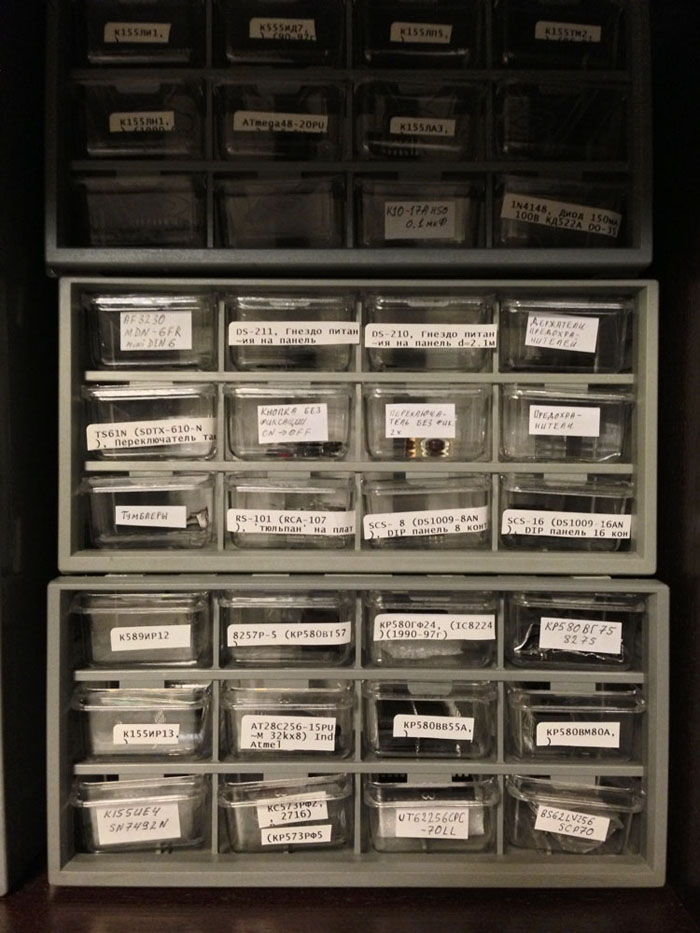
In addition to the details, I also needed tools, because my favorite 36V soldering iron disappeared without a trace somewhere in the whirlwind of perestroika. Having decided to start with a soldering iron, I realized how much everything has changed since my childhood. I didn’t do much research on this subject, to be honest - I just looked into the store and picked from the shelf what I liked in appearance - namely, the ERSA i-CON pico soldering station. Already at home I discovered how much this tool is incomparably better than what I had to deal with before. It is clear that you can set the temperature of the tip, which will be maintained with great accuracy even during the soldering process. You can even load temperature curves from the SD card! True, I did not begin to understand why an ordinary person might need it, but it sounds cool! I'd rather dwell on more obvious things,
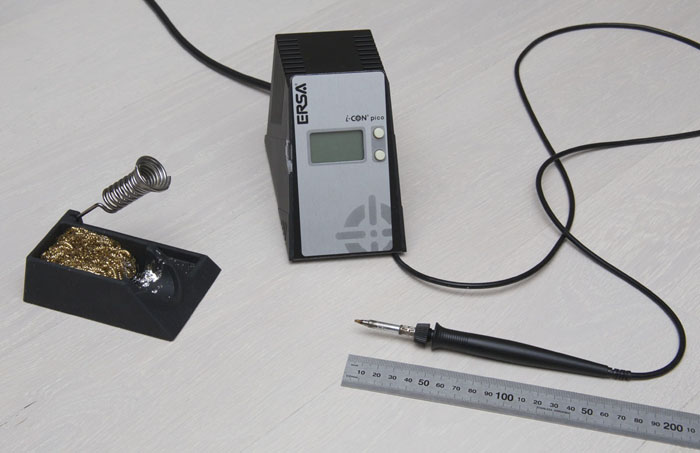
Firstly, the size and weight of the soldering iron, as well as the quality of the cable are beyond praise. In the hands of the soldering iron is almost not felt, the cable is very flexible and heat-resistant - if you accidentally touch the sting, then there are no traces on the insulation at all. I think that the handle of my old soldering iron weighed more than the entire soldering iron from ERSA, and there was nothing to say about the cable - it was thick, hard, and when touched with a sting it melted immediately and smoked vilely.
Secondly, the heating of the sting is almost instantaneous (like they write about 9 seconds). The heating element is located almost inside the tip, so there is no loss of time for heating up unnecessary parts, and the tip temperature is thus supported incomparably better. At the same time, there is no heating of the soldering iron handle - my old soldering iron was impossible to hold in my hands after an hour of work, the handle was so heated. Here the impression is that the only source of warming up the pen is the warmth of my own fingers.
Thirdly, the broadest choice of stings, also non-fireproof. The choice is so wide that I could not finally decide what suits me more for certain operations. By the way, a sting change takes literally seconds. Fireproofing greatly saved time, and did not have to be distracted at the most inopportune moment when cleaning the sting. A small distraction - once in my childhood, repairing a TV and being immersed in it almost to the waist, thinking, I automatically tried to clean the soldering iron tip, licking it with my tongue. For more than a week I could not eat anything solid ...
Fourth, I was struck by the power of this miniature soldering iron. An old soldering iron with noticeably large sizes and three times as much weight was 25 watts. When buying a soldering station, I did not even look at the power, deciding that for small parts a watt of 20, which, obviously, can be expected, will be enough, and for larger things I will buy something more powerful. What was my surprise when I discovered that the power of this soldering iron is 80 watts! Therefore (using appropriate stings) he could completely satisfy me in terms of soldering any conceivable details.
The next item in the toolbox was a normal desk lamp. On the ChiD website, I saw something called the "Shadeless table lamp, luminescent." Given such an interesting name, as well as a rather big price, I expected to get something in the High-Tech style, with decent quality. What was my disappointment when they brought this lamp to me ... Not only the workmanship, but even the design and constructive solutions are so terrible that I could not seriously believe that it was mass-produced! The switch broke after the third switch-on, which led to the need to disassemble the lamp and get even more amazed at the circuitry (there isn’t even a starter there, and the lamps are ignited by a mechanical switch that you press at the time of switching on - that is, while pressing with your finger on the thread voltage is applied).
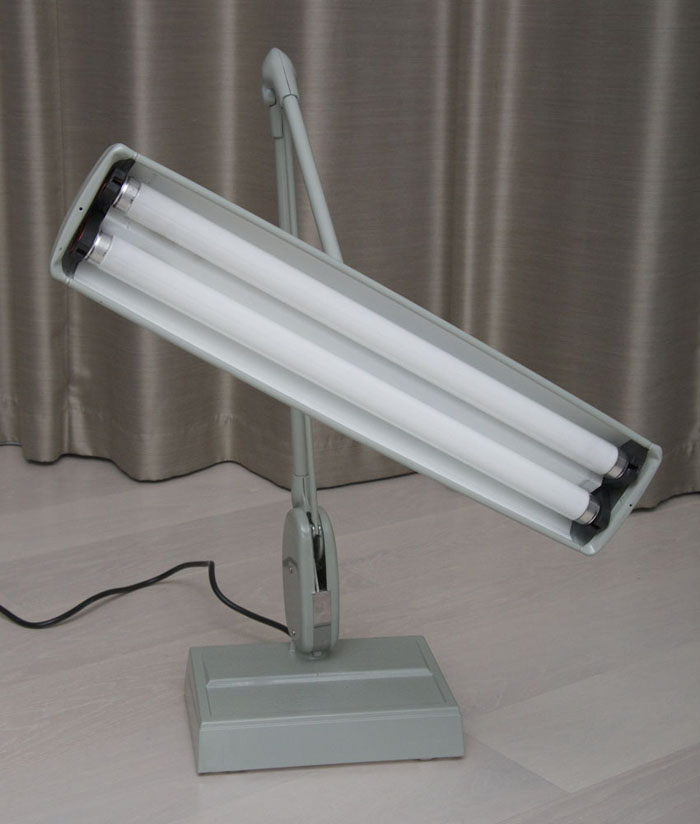
If I chose a soldering iron simply by appearance, then I approached the choice of a tool for stripping MGTF wire seriously - I used yandex. To my surprise, it became clear that such a tool simply does not exist! All existing tools simply cannot handle fluoroplastic insulation, especially if the wire is thin. In childhood, own teeth were successfully used for this, but now this option was no longer suitable. In the end, he settled on the thermal method - first, the tip of the wire is heated with a soldering iron in rosin (so that a small drop of rosin remains on the wire), and then this tip is immersed for a couple of seconds in the molten solder. For this procedure, some experts recommended modifying the soldering iron tip, but I decided to go ahead and buy a whole soldering bath. Sounds loud but in reality it’s a rather small thing, which, nevertheless, turned out to be almost ideal for my needs. After some experiments, a temperature was found at which the strictly necessary amount of wire was stripped almost independently of the time of immersion. In addition, the wire immediately turned out to be well tinned, which also accelerated the work. I believe that this decision saved me a lot of time and nerves.

True, there is one unpleasant nuance with this method of cleaning - when heated above a certain temperature, the fluoroplastic decomposes into components, including the chemical warfare phosgene. Of course, I understood that the amount of these substances is such that even with a year of continuous wire stripping, I’m unlikely to get at least some dangerous amount of gas, but I didn’t want to get extra odors from home. Therefore, I was happy to understand that this is a very good reason to buy another toy on the ChiD website - “Smoke Absorber on a Tripod”. It is just a small exhaust fan that draws air through a replaceable carbon filter. In general, the device seemed to work fine - the level of odors from soldering and cleaning wires when using a smoke absorber was actually much lower than without it. And the white coating on the filter that appeared at the end of the project also made me think that without a smoke absorber this coating would be in the air (and then in our lungs). The only thing is the noise level of the device is much higher than we would like. Especially considering that the smoke absorber was forced to be right next to my head, after a couple of hours my head began to swell from the noise of the fan.

The last device I bought for this project was the ChipProg-48 chip programmer. It is clear that it was possible to get by with a much simpler and cheaper device (or just assemble myself what I once did), but I wanted to get a device that can do anything. A product of Russian manufacture, made quite normal, the software also looks more or less. The charm of the device is that there is practically no serial chip that this programmer can not flash. And even if something completely new appears, then updating the programmer software solves this problem.

Finally, the assembly process could begin. I decided to put all the microcircuits in the sockets - the idea of the potential need to re-solder the microcircuit, to which 10 to 100 wires are already soldered, did not inspire me with joy (I never liked to redo what was already done).
The first step was the installation of panels, connectors and blocking capacitors. This did not take much time, and before that, a completely clean breadboard suddenly changed and became already similar to something.
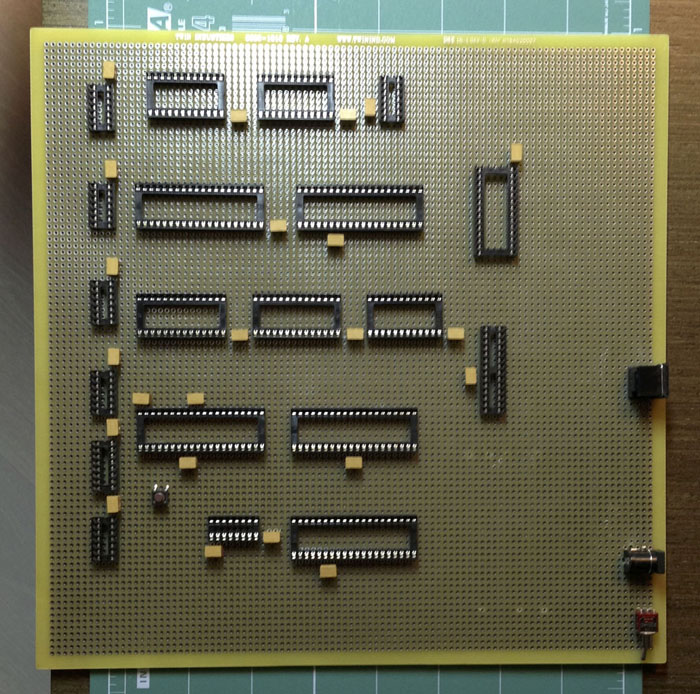
The next step was to separate the power wires and installed 3 LEDs indicating the presence of power on the processor. In general, I wanted to do it beautifully, so I decided to use the wire much thicker than necessary for power. Unfortunately, this did not add beauty, but it created problems. Such a wire in the solder bath was not cleaned, so I had to use wire cutters, and this is a lot of lost time. And the installation of such a wire is also more complicated than a thin MGTF. By the time this became clear, it was too late to redo something, so I had to finish the job.

After installing the power wires, the probe checked the correctness of the connections and could not resist so as not to supply power to the board. Not only did nothing smoke, but even all three LEDs lit up, which further inspired - at least something worked!
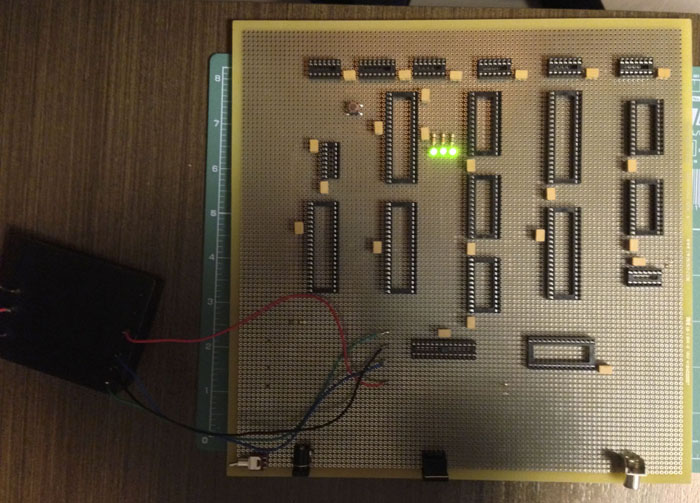
Next went the process of mounting the main wires. To do this, I used MGTF with a cross section of 0.05 sq. Mm., Although, probably, it was worth taking 0.03 - it would be even more fun. After installing most of the wires, I realized that everything could be done on a smaller board - there was a lot of empty space left. Although, in my opinion, it looks a bit more interesting.

Having finished with almost all the wires connecting the microcircuits, I installed the remaining elements - a small number of resistors, transistors and capacitors, as well as a power supply.

During the installation, “loose streaks” added a few more installation wires, and was surprised to realize that the installation part of the process seems to be over.
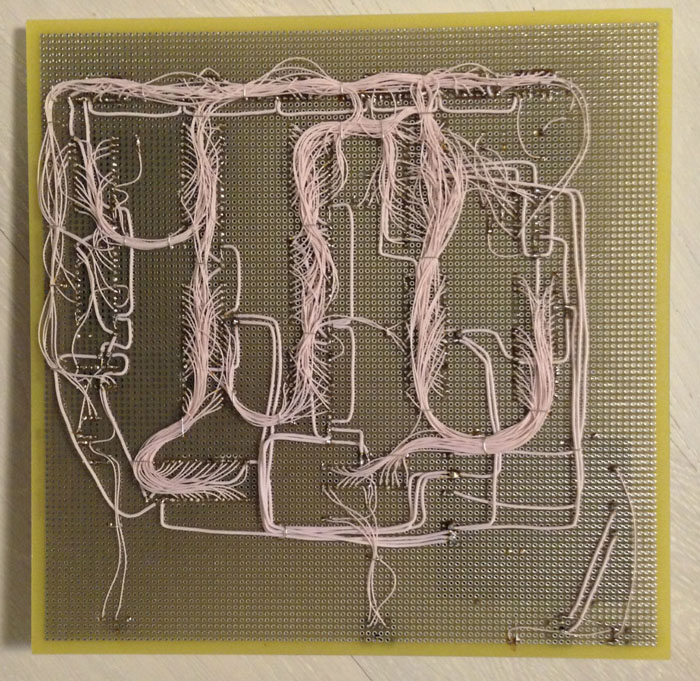
To be honest, I somehow could not believe it, but the address bus and data dialer did not find any errors in this part of the installation, I decided to check the rest already at the start-up phase.
It's time to use the programmer. It was necessary to program the microcircuit of the 573RF2 character generator and the 573RF6 monitor. Unfortunately, the problem immediately popped up. The programmer categorically refused to work with RF6 - at the beginning of programming, he stopped and reported a faulty leg. Moreover, both available chips behaved identically. I still did not understand what was the matter - the microcircuits are really faulty, the programmer is working incorrectly, or am I using the programmer incorrectly. I just went to the store and bought an imported microcircuit, which was flashed without any problems.
With RF2, a similar problem also arose. The programmer immediately declared a faulty foot (although I don’t understand how to determine the malfunction of that particular input), but at the same time he programmed the microcircuit, and checking the contents showed that the programming was successful.
After a hitch with the ROM, everything was ready for installing chips in the panel. As expected, the imported microcircuits became ideal in the imported panels, but Russian cases with metric dimensions climbed into the inch panels not very willingly. However, this is a known and, most often, not very serious problem.

Finally, the solemn moment of turning on the power came. I understood that such a design, assembled by wires on a breadboard, could not work immediately, in principle, so I did not even connect the video input of the TV. The main thing is that after turning on the power, smoke didn’t seem to come out of nowhere, well, that's good. Next, I took an oscilloscope and looked at the main signals on the processor. To my surprise, they looked like something was working, so I decided to take a look at what was happening on the video output. The strangest thing is that on the video output the oscilloscope showed the presence of a completely meaningful signal, with pulses of horizontal and vertical scans. Considering that in 86РК the video signal is generated by a video controller that requires programming of settings, as well as participation in the direct memory access system, the presence of such a signal indicated that that a lot of things in the system (if not everything at all) work correctly. Not believing in himself, he connected the TV and after a few seconds he watched the sign that I had dreamed about repeatedly in 1986 - “RADIO-86RK”, an arrow and a blinking cursor!
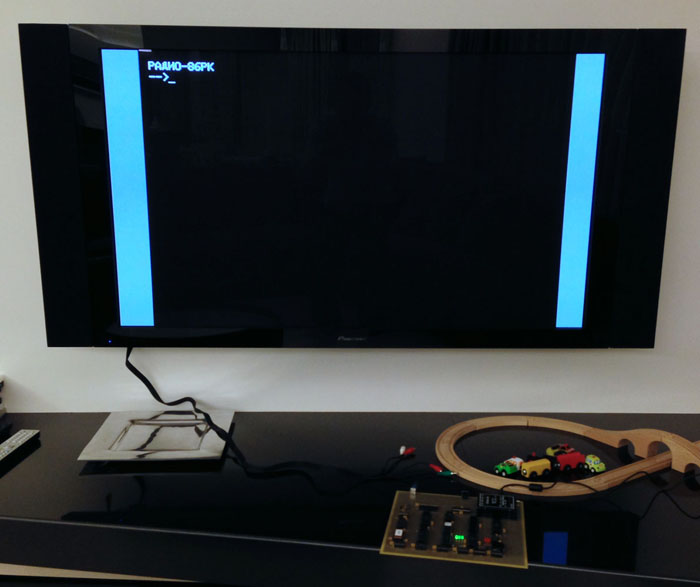
On the one hand, it was joyful, but, on the other hand, it was a little sad - the dream came true, which means that it no longer exists. Maybe it wasn’t necessary to take it at all, even if everything remained so?
For dessert, I decided to give the device a slightly more finished look. First I read how to cut plexiglass, then I bought everything in the same “ChiD” piece of plexiglass, a cutter, racks on the board and legs for radio devices and put it all into action.


Well, to top it off, I wrote one program to the ROM drive to demonstrate to my family that this is still a real computer!
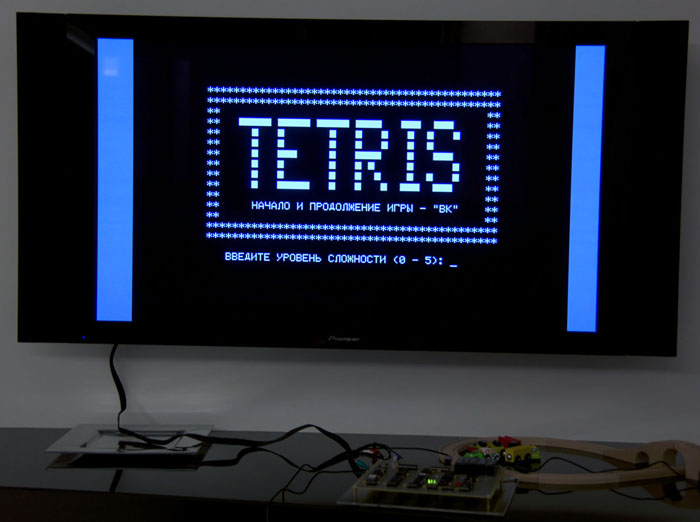
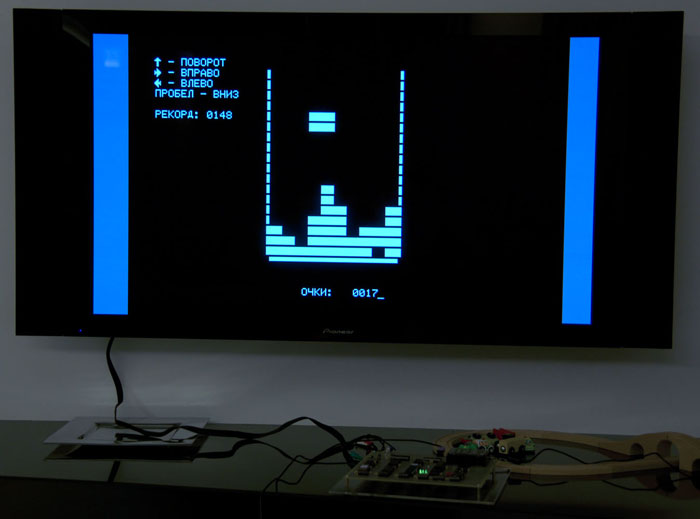
Prior to that, I already figured out a bit with microprocessor technology a series of publications several years earlier in the same Radio about the construction of the Micro Micro 80 microcomputer. Unfortunately, the Micro 80 circuitry was extremely complex (more than 200 microcircuits), so it was almost impossible for me to repeat it, both because of the complexity of the construction and the inability to get the details.
So for the time being, I could only write programs on machine codes in a notebook in a box and dream of a magician in a helicopter of any color that would suddenly give me this very Micro 80.
The situation has changed to some extent after the publication of articles on Radio 86RK. 86РК was much simpler - it contained "only" 29 chips. Only if before that I clearly understood that there was no chance at all, then it seems like the opportunity to get my own micro-computers theoretically appeared, but practically the question with details was almost unresolved anyway.
Let me explain a little - at that time everything was in short supply, and radio components were no exception to this rule. Not only that, many parts, in principle, did not go on retail. Nevertheless, it was possible to get everything. In large cities there were places (often near shops like "Young Technician", etc.), where it was worth standing for a minute or two with an absent look, as "comrades" who were spinning nearby came up to you and casually asked - "Is something necessary? ". Naturally, such activity was completely illegal, and was regularly suppressed by the relevant law enforcement bodies. As in any criminal business, there was always a danger that you would be deliberately “thrown”, “divorced” or even “framed”. Accordingly, to me, as a resident of a small village, this option was of little use - and it was logistically extremely difficult, and it was just scary.
Therefore, my mood only got spoiled - it’s better to clearly know that this is impossible, than to constantly suffer, wondering if it is possible to dodge somehow and find the necessary components. A couple of years passed in such torment, I went to study at a university in one of the largest cities of the Union, and the ghost of 86RK became more distinct. Having cooperated with a friend, we made a sortie to the Elektronika brand store, easily attracted the attention of the “merchants” who were there and became the owners of an almost complete set of everything necessary for assembling the RC - from microcircuits to the board and keyboard buttons.
Further, everything went somehow wrong. Now it’s even difficult for me to understand / remember why we didn’t succeed. The fact remains - that computer did not work.
I had many childhood dreams / desires of completely different scales and importance, and most of them came true. However, a couple of months ago I suddenly realized that it seems that there remains one more unrealized, but firmly sunken somewhere in the back of my mind dream - still to build Radio 86RK. And not to buy, but to build it myself, and as close as possible to what I could do more than 20 years ago.
To date, for almost 20 years I have not picked up a soldering iron and an oscilloscope, so some of my skills were lost and forgotten. Nothing - I decided that it would even be more interesting.
First, it was necessary to decide on some basic things. Firstly, the specific circuit of the device. It is clear that there is a completely original scheme published in Radio in 1986, but even then corrections / additions were repeatedly published to it. In addition, one of the weakest points of 86РК was RAM. In the basic version, its volume was 16K (namely, sixteen KILObytes), and it was organized on 8 565RU3 microcircuits. Even the new RU3s did not work very reliably, and how the products of more than 20 years ago will work (new ones, of course, have not been produced long ago) could be confidently assumed. On the other hand, I didn’t really want to depart from the original, because you could just assemble an emulator on an FPGA or even an AVR. Therefore, on the Internet, a scheme was found using modern SRAM memory. In addition to reducing the number of memory cases (instead of 16 pieces of RU3 for the 32K version, only one is needed), a couple of microcircuits were also thrown, which ensured that the old memory was working. Nevertheless, everything else (including the memory address space) absolutely corresponded to the original, i.e. any programs for the original 86РК will be able to work on this option, even if they access the hardware resources directly.
The second big decision was to choose which board to do it all on. A very nice printed circuit board was also provided for the circuit found, which, moreover, could be bought. However, it seemed to me that it would be somehow dishonest - too simple. Indeed, in the same place it was possible to buy a completely assembled computer ... Therefore, it was decided to go, probably, in the most difficult way - a breadboard with installation of MGTF wire.
Next, you had to choose a power supply circuit. The options were from using the most original scheme (a rather stupid implementation of the classic PSU) to using a standard ATX format PSU. 86RK (or rather, the 580VM80 microprocessor) requires 3 supply voltages (+5, -5 and +12 V) and many power supplies from a regular PC-bus provide this. In the end, I decided to use a standard power module installed on the board. At the input of this, something from 9 to 36 V is supplied, at the output we get the three necessary voltages, and even with the desired on / off sequence.
The last question, which I spent some time thinking about, is what to do with the keyboard. It was tempting to make a printed circuit board by trying LUT (laser-ironing technology) for the original keyboard, but, in the end, it became interesting to deal with modern technologies a bit, so I decided to leave the PS / 2 adapter for the keyboard built on the ATMega 48 microcontroller. In fact, this adapter connects to the 86PK and mimics the original 86PK matrix keyboard, while on the other hand this adapter has the most common modern PC keyboard with PS / 2 interface (USB is much more difficult to implement). It is curious that the computing power of this microcontroller is much higher than that of the entire 86РК computer ...
Finally, it’s time to start shopping for various crap, figs and garbage. I always liked it - as they say, equipment is most important. It doesn’t matter that you don’t know how to dress her properly, but you look cool! Yes, and there is a feeling that I'm ready for everything and you can :)
I will say right away that the budget of the event did not bother me at all, the main thing was to spend a minimum of time and nerves searching for everything necessary. Therefore, it was decided to buy everything in the Chip & Dip online store. Just in case, everything was bought in double quantity - suddenly something is broken or does not work, but I have just a creative impulse! Basically, there were no big problems, although there were some overlays. But I can’t help but speak out at prices - probably, if I spent a little time and went (virtually or physically) to other places, then 90% of the main components could be bought ten times cheaper - and this is not an exaggeration. The fact is, the microcircuits I need are practically not used in modern conditions, therefore the concept of “market price” is simply absent on them. So you can find them from “free” (just by searching on the appropriate forums) to “Chip and Dip” (that is, it’s even strangely expensive - they made a mistake in the currency, or what?). At the same time, I understand that this is the business of the store itself, and I am not complaining, just stating a fact.
In general, of course, the ChiD site is a terrible place. I think that if in childhood I had the opportunity to acquire in this everything that my heart desires, then I would just have a heart break. Even now it was difficult for me to tear myself away from justifying to myself why I definitely needed to buy that garbage. The site itself is made quite normal and convenient, with a decent amount of information. At least, I did not even see anything close to other Russian component sellers.
As already said, in order to reduce hassle and save time, I found absolutely everything I needed in Chip and Deep. Everything, with the exception of almost the most important thing - the breadboard. With some surprise, I found that the board size I needed (namely, I wanted at least 20x20 cm) could not be found anywhere else. I had to turn to Google and after 10 minutes I ordered a 10x10-inch board at Twin Industries, USA. Given the urgent shipment, all this cost me the cost of an inexpensive tablet, but to walk like that for a walk!

While dealing with the boards, the first deliveries from Chip and Deep arrived. And again I can not help but speak out about the prices of some positions. To have a place to store my treasures, I ordered several cassettes. The price initially seemed very high, but there was a hope to get something completely glamorous for the money. Unfortunately, even my children’s cassette from matchboxes looked (and worked) better. I honestly don’t understand how this is ... you can even try to sell for the money! Moreover, the matter is not only (and not so much) in appearance - the workmanship and ergonomics of use are simply terrible!

In addition to the details, I also needed tools, because my favorite 36V soldering iron disappeared without a trace somewhere in the whirlwind of perestroika. Having decided to start with a soldering iron, I realized how much everything has changed since my childhood. I didn’t do much research on this subject, to be honest - I just looked into the store and picked from the shelf what I liked in appearance - namely, the ERSA i-CON pico soldering station. Already at home I discovered how much this tool is incomparably better than what I had to deal with before. It is clear that you can set the temperature of the tip, which will be maintained with great accuracy even during the soldering process. You can even load temperature curves from the SD card! True, I did not begin to understand why an ordinary person might need it, but it sounds cool! I'd rather dwell on more obvious things,

Firstly, the size and weight of the soldering iron, as well as the quality of the cable are beyond praise. In the hands of the soldering iron is almost not felt, the cable is very flexible and heat-resistant - if you accidentally touch the sting, then there are no traces on the insulation at all. I think that the handle of my old soldering iron weighed more than the entire soldering iron from ERSA, and there was nothing to say about the cable - it was thick, hard, and when touched with a sting it melted immediately and smoked vilely.
Secondly, the heating of the sting is almost instantaneous (like they write about 9 seconds). The heating element is located almost inside the tip, so there is no loss of time for heating up unnecessary parts, and the tip temperature is thus supported incomparably better. At the same time, there is no heating of the soldering iron handle - my old soldering iron was impossible to hold in my hands after an hour of work, the handle was so heated. Here the impression is that the only source of warming up the pen is the warmth of my own fingers.
Thirdly, the broadest choice of stings, also non-fireproof. The choice is so wide that I could not finally decide what suits me more for certain operations. By the way, a sting change takes literally seconds. Fireproofing greatly saved time, and did not have to be distracted at the most inopportune moment when cleaning the sting. A small distraction - once in my childhood, repairing a TV and being immersed in it almost to the waist, thinking, I automatically tried to clean the soldering iron tip, licking it with my tongue. For more than a week I could not eat anything solid ...
Fourth, I was struck by the power of this miniature soldering iron. An old soldering iron with noticeably large sizes and three times as much weight was 25 watts. When buying a soldering station, I did not even look at the power, deciding that for small parts a watt of 20, which, obviously, can be expected, will be enough, and for larger things I will buy something more powerful. What was my surprise when I discovered that the power of this soldering iron is 80 watts! Therefore (using appropriate stings) he could completely satisfy me in terms of soldering any conceivable details.
The next item in the toolbox was a normal desk lamp. On the ChiD website, I saw something called the "Shadeless table lamp, luminescent." Given such an interesting name, as well as a rather big price, I expected to get something in the High-Tech style, with decent quality. What was my disappointment when they brought this lamp to me ... Not only the workmanship, but even the design and constructive solutions are so terrible that I could not seriously believe that it was mass-produced! The switch broke after the third switch-on, which led to the need to disassemble the lamp and get even more amazed at the circuitry (there isn’t even a starter there, and the lamps are ignited by a mechanical switch that you press at the time of switching on - that is, while pressing with your finger on the thread voltage is applied).

If I chose a soldering iron simply by appearance, then I approached the choice of a tool for stripping MGTF wire seriously - I used yandex. To my surprise, it became clear that such a tool simply does not exist! All existing tools simply cannot handle fluoroplastic insulation, especially if the wire is thin. In childhood, own teeth were successfully used for this, but now this option was no longer suitable. In the end, he settled on the thermal method - first, the tip of the wire is heated with a soldering iron in rosin (so that a small drop of rosin remains on the wire), and then this tip is immersed for a couple of seconds in the molten solder. For this procedure, some experts recommended modifying the soldering iron tip, but I decided to go ahead and buy a whole soldering bath. Sounds loud but in reality it’s a rather small thing, which, nevertheless, turned out to be almost ideal for my needs. After some experiments, a temperature was found at which the strictly necessary amount of wire was stripped almost independently of the time of immersion. In addition, the wire immediately turned out to be well tinned, which also accelerated the work. I believe that this decision saved me a lot of time and nerves.

True, there is one unpleasant nuance with this method of cleaning - when heated above a certain temperature, the fluoroplastic decomposes into components, including the chemical warfare phosgene. Of course, I understood that the amount of these substances is such that even with a year of continuous wire stripping, I’m unlikely to get at least some dangerous amount of gas, but I didn’t want to get extra odors from home. Therefore, I was happy to understand that this is a very good reason to buy another toy on the ChiD website - “Smoke Absorber on a Tripod”. It is just a small exhaust fan that draws air through a replaceable carbon filter. In general, the device seemed to work fine - the level of odors from soldering and cleaning wires when using a smoke absorber was actually much lower than without it. And the white coating on the filter that appeared at the end of the project also made me think that without a smoke absorber this coating would be in the air (and then in our lungs). The only thing is the noise level of the device is much higher than we would like. Especially considering that the smoke absorber was forced to be right next to my head, after a couple of hours my head began to swell from the noise of the fan.

The last device I bought for this project was the ChipProg-48 chip programmer. It is clear that it was possible to get by with a much simpler and cheaper device (or just assemble myself what I once did), but I wanted to get a device that can do anything. A product of Russian manufacture, made quite normal, the software also looks more or less. The charm of the device is that there is practically no serial chip that this programmer can not flash. And even if something completely new appears, then updating the programmer software solves this problem.

Finally, the assembly process could begin. I decided to put all the microcircuits in the sockets - the idea of the potential need to re-solder the microcircuit, to which 10 to 100 wires are already soldered, did not inspire me with joy (I never liked to redo what was already done).
The first step was the installation of panels, connectors and blocking capacitors. This did not take much time, and before that, a completely clean breadboard suddenly changed and became already similar to something.

The next step was to separate the power wires and installed 3 LEDs indicating the presence of power on the processor. In general, I wanted to do it beautifully, so I decided to use the wire much thicker than necessary for power. Unfortunately, this did not add beauty, but it created problems. Such a wire in the solder bath was not cleaned, so I had to use wire cutters, and this is a lot of lost time. And the installation of such a wire is also more complicated than a thin MGTF. By the time this became clear, it was too late to redo something, so I had to finish the job.

After installing the power wires, the probe checked the correctness of the connections and could not resist so as not to supply power to the board. Not only did nothing smoke, but even all three LEDs lit up, which further inspired - at least something worked!

Next went the process of mounting the main wires. To do this, I used MGTF with a cross section of 0.05 sq. Mm., Although, probably, it was worth taking 0.03 - it would be even more fun. After installing most of the wires, I realized that everything could be done on a smaller board - there was a lot of empty space left. Although, in my opinion, it looks a bit more interesting.

Having finished with almost all the wires connecting the microcircuits, I installed the remaining elements - a small number of resistors, transistors and capacitors, as well as a power supply.

During the installation, “loose streaks” added a few more installation wires, and was surprised to realize that the installation part of the process seems to be over.

To be honest, I somehow could not believe it, but the address bus and data dialer did not find any errors in this part of the installation, I decided to check the rest already at the start-up phase.
It's time to use the programmer. It was necessary to program the microcircuit of the 573RF2 character generator and the 573RF6 monitor. Unfortunately, the problem immediately popped up. The programmer categorically refused to work with RF6 - at the beginning of programming, he stopped and reported a faulty leg. Moreover, both available chips behaved identically. I still did not understand what was the matter - the microcircuits are really faulty, the programmer is working incorrectly, or am I using the programmer incorrectly. I just went to the store and bought an imported microcircuit, which was flashed without any problems.
With RF2, a similar problem also arose. The programmer immediately declared a faulty foot (although I don’t understand how to determine the malfunction of that particular input), but at the same time he programmed the microcircuit, and checking the contents showed that the programming was successful.
After a hitch with the ROM, everything was ready for installing chips in the panel. As expected, the imported microcircuits became ideal in the imported panels, but Russian cases with metric dimensions climbed into the inch panels not very willingly. However, this is a known and, most often, not very serious problem.

Finally, the solemn moment of turning on the power came. I understood that such a design, assembled by wires on a breadboard, could not work immediately, in principle, so I did not even connect the video input of the TV. The main thing is that after turning on the power, smoke didn’t seem to come out of nowhere, well, that's good. Next, I took an oscilloscope and looked at the main signals on the processor. To my surprise, they looked like something was working, so I decided to take a look at what was happening on the video output. The strangest thing is that on the video output the oscilloscope showed the presence of a completely meaningful signal, with pulses of horizontal and vertical scans. Considering that in 86РК the video signal is generated by a video controller that requires programming of settings, as well as participation in the direct memory access system, the presence of such a signal indicated that that a lot of things in the system (if not everything at all) work correctly. Not believing in himself, he connected the TV and after a few seconds he watched the sign that I had dreamed about repeatedly in 1986 - “RADIO-86RK”, an arrow and a blinking cursor!

On the one hand, it was joyful, but, on the other hand, it was a little sad - the dream came true, which means that it no longer exists. Maybe it wasn’t necessary to take it at all, even if everything remained so?
For dessert, I decided to give the device a slightly more finished look. First I read how to cut plexiglass, then I bought everything in the same “ChiD” piece of plexiglass, a cutter, racks on the board and legs for radio devices and put it all into action.


Well, to top it off, I wrote one program to the ROM drive to demonstrate to my family that this is still a real computer!


